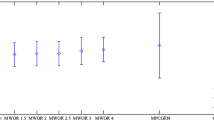Abstract
To evade signature-based detection, metamorphic viruses transform their code before each new infection. Software similarity measures are a potentially useful means of detecting such malware. We can compare a given file to a known sample of metamorphic malware and compute their similarity—if they are sufficiently similar, we classify the file as malware of the same family. In this paper, we analyze an opcode-based software similarity measure inspired by simple substitution cipher cryptanalysis. We show that the technique provides a useful means of classifying metamorphic malware.




Similar content being viewed by others
Notes
For Jackobsen’s simple substitution attack, it is not necessary to normalize the matrices, since the scores are only used internally for a hill climb and the desired result is the key \(K\). However, when scoring metamorphic malware, the desired result is the score, and we want to compare scores for different viruses. Consequently, it is necessary that these scores be independent of the input length.
References
Attaluri, S., McGhee, S., Stamp, M.: Profile hidden Markov models and metamorphic virus detection. J. Comput. Virol. 5(2), 151–169 (2009)
Aycock, J.: Computer Viruses and Malware. Springer, Berlin (2006)
Austin, T.H. et al.: Exploring hidden Markov models for virus analysis: A semantic approach, Proceedings of 46th Hawaii International Conference on System Sciences (HICSS 46), January 7–10 (2013)
Baysa, D., Low, R.M., Stamp, M.: Structural entropy and metamorphic malware, submitted
Bilar, D.: Opcodes as predictor for malware. Int. J. Electron. Secur. Digit. Forensics 1(2), 156–168 (2007)
Borello, J., Me, L.: Code obfuscation techniques for metamorphic viruses. J. Comput. Virol. 4(3), 30–40 (2008)
Bradley, A.P.: The use of the area under the roc curve in the evaluation of machine learning algorithms. Pattern Recognit. 30, 1145–1159 (1997)
Cygwin, Cygwin Utility Files, http://www.cygwin.com/
Desai, P.: Towards an undetectable computer virus, Master’s report, Department of Computer Science, San Jose State University (2008). http://scholarworks.sjsu.edu/etd_projects/90/
Deshpande, S.: Eigenvalue Analysis for Metamorphic Detection, Master’s report, Department of Computer Science, San Jose State University (2012). http://scholarworks.sjsu.edu/etd_projects/279/
Dhavare, A., Low, R.M., Stamp, M.: Efficient cryptanalysis of homophonic substitution ciphers. to appear in Cryptologia
Filiol, E.: Metamorphism, formal grammars and undecidable code mutation. Int. J. Comput. Sci. 2, 70–75 (2007)
Idika, N., Mathur, A.: A Survey of Malware Detection Techniques, Technical report, Department of Computer Science, Purdue University (2007). http://www.serc.net/system/files/SERC-TR-286.pdf
Islita, M.: Levenshtein Edit Distance (2006). http://www.miislita.com/searchito/levenshtein-edit-distance.html
Jakobsen, T.: A fast method for the cryptanalysis of substitution ciphers. Cryptologia 19, 265–274 (1995)
Lin, D., Stamp, M.: Hunting for undetectable metamorphic viruses. J. Comput. Virol. 7(3), 201–214 (2011)
Mathai, J.: History of Computer Cryptography and Secrecy System. http://www.dsm.fordham.edu/mathai/crypto.html
Patel, M.: Similarity Tests for Metamorphic Virus Detection, Master’s report, Department of Computer Science, San Jose State University, (2011). http://scholarworks.sjsu.edu/etd_projects/175/
Rad, B.B., Masrom, M., Ibrahim, S.: Evolution of computer virus concealment and anti-virus techniques: a short survey. IJCSI Int. J. Comput. Sci. Issues 8(1) (2011). http://arxiv.org/pdf/1104.1070.pdf
Runwal, N., Low, R.M., Stamp, M.: Opcode graph similarity and metamorphic detection. J. Comput. Virol. 8(1–2), 37–52 (2012)
Shanmugam, G.: Simple Substitution Distance and Metamorphic Detection, Master’s report, Department of Computer Science, San Jose State University (2012). http://scholarworks.sjsu.edu/etd_projects/270/
Snakebyte. Next Generation Virus Construction Kit (NGVCK) (2000). http://vx.netlux.org/vx.php?id=tn02
Sorokin, I.: Comparing files using structural entropy. J. Comput. Virol. 7(4), 259–265 (2011)
Sridhara, S.M., Stamp, M.: Metamorphic worm that carries its own morphing engine. to appear in J. Comput. Virol.
Stamp, M.: Information Security: Principles and Practice, 2nd edn. Wiley, Hoboken (2011)
Stamp, M., Low, R.M.: Applied Cryptanalysis: Breaking Ciphers in the Real World. Wiley-IEEE Press, Chichester (2007)
Szor, P., Ferrie, P.: Hunting for Metamorphic, Symantec Security Response. http://www.symantec.com/avcenter/reference/hunting.for.metamorphic.pdf
Toderici, A.H., Stamp, M.: Chi-squared distance and metamorphic virus detection. to appear in J. Comput. Virol.
Venkatachalam, S., Stamp, M.: Detecting undetectable computer viruses. Proceedings of 2011 International Conference on Security & Management (SAM ’11), pp. 340–345
Wong, W., Stamp, M.: Hunting for metamorphic engines. J. Comput. Virol. 2(3), 211–229 (2006)
Zbitskiy, P.: Code mutation techniques by means of formal grammars and automatons. J. Comput. Virol. 5(3), 199–207 (2009)
Author information
Authors and Affiliations
Corresponding author
Rights and permissions
About this article
Cite this article
Shanmugam, G., Low, R.M. & Stamp, M. Simple substitution distance and metamorphic detection. J Comput Virol Hack Tech 9, 159–170 (2013). https://doi.org/10.1007/s11416-013-0184-5
Received:
Accepted:
Published:
Issue Date:
DOI: https://doi.org/10.1007/s11416-013-0184-5




